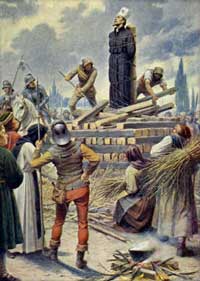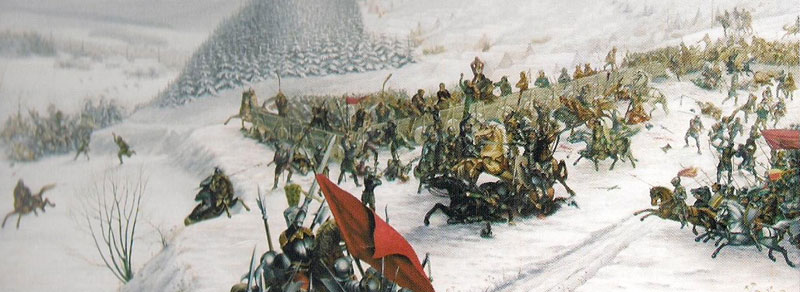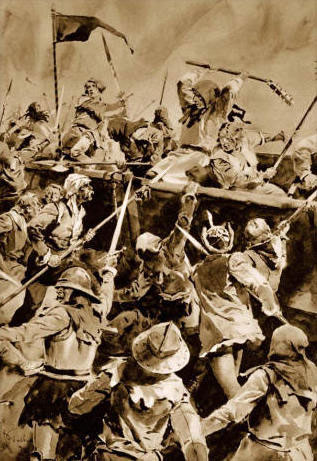Not everyone knows that at the beginning of the 15th century the Czechs rebelled against the Roman Catholic Church and founded their own religious movement called Hussitism. The escalation of the conflict led to armed crusades on their lands, but the Hussite armies brutally defeated practically everyone who dared to enter their lands. The effectiveness of their tactics and command was so great that German and Silesian knights were capable of escaping from the battlefield at the very sight of Czech combat wagons.
Religious revolution in medieval Bohemia

Wikimedia Commons
In Europe, at the turn of the fourteenth and fifteenth centuries, there was the so-called Great Schism, a conflict over the power of two popes (one Roman and the other, who resided in Avignon). This period, when faith itself was less important than politics, pushed many believers away from the Church. Reformist movements began to come to the fore, one of which was the Czech professor and preacher Jan Hus. Based on the views of the radical Oxford theologian John Wycliffe, this man claimed, among other things, that Devotions should be held in Czech, communion in two forms, the Church itself should return to the early strict principles of Christianity, and the Bible was the only criterion of faith. As you can guess, the teachings of Huss did not bring him any followers within the structures of the Church. However, he was summoned to the Council of Constance, where, despite having a safe conduct pass, he was burned at the stake after a directed trial.
In Bohemia it was boiling. The majority of the population supported the “Hussites”, and King Wenceslaus IV tried incompetently to control the nervous atmosphere in the country, but the result was an escalation of the conflict, and on July 30, 1419, Bohemia was overtaken by an insurrection. The church property was confiscated and the clergy were expelled from their parishes and robbed.
Birth of Hussite armed forces
When the country was on the verge of civil war, the field troops of the Hussites began to form, which were commanded by military leaders called “hejtmans”. The most eminent of them was the famous Jan Žižka, the general derived from the radical Hussite called Taborites. It was he who, commanding the Tabor in March 1425, having in front of him the predominant forces of the Catholic nobleman Bohuslav of Švamberk, during the battle used wagons connected with each other by wheels, defended by infantry. The new tactics were very successful and Žižka fought in this way also shortly afterwards, near Sudoměř , where the charge of heavy armoured knights attacked a wagenburg (the wagon fort) created by the Czechs. The riders were held back by the rain of bullets and bolts released from the wagenburg, and even if only a few managed to get to the vicinity of the carts, they were eliminated by the crews. In addition, the charge was hindered by the deep fog through which the knights ravaged each other. This way of fighting was perpetuated and used with brutal effectiveness by the Hussite armed forces over the following years.

Robert Hauk via Wikimedia Commons
The main and most dangerous opponent of Hussite armies was the heavy cavalry. The Czechs resisted its crushing charges by defending themselves from behind the cover provided by the combat wagons, giving in the direction of the knights a salvo of crossbows, as well as primitive firearms. During hand-to-hand combat swords, cords, flails and spears were used. The crew of one combat vehicle consisted of two riflemen with guns, six crossbowmen, and twelve infantrymen with flails, swords, pole arms and shields. The equipment of the wagon made it possible for the crew to quickly shoot a deadly rain of arrows and bullets in the direction of the coming charge, and if the enemy managed to reach a wagon, his crew defended themselves both on it and under it – often a man was lying under the wagon, whose task was to cut the legs of knights’ horses. All this made the attack of the 15th century cavalry on the Hussite wagenburg often doomed to failure. The knights had a chance in a clash with Hussites only when their charge surprised the Czechs during the march, and the carts were not tied together.
“From behind the shields of the Silesian infantry crossbows appeared. Haugwitz shouted to hoarseness, forbade to shoot, ordered to wait. It was a mistake. When the cavalry approached for three hundred steps, Hussites began to fire from their wagons, a hail of bullets hit the target. In a moment a dense cloud of bolt flew to the Silesians. Immediately, many dead fell to the ground, the wounded shouted, the line of shields was shaken, Silesian infantrymen responded with fire, but chaotic and unceiling. The shooters’ hands were shaking. Because at Bleh’s command, Hussite troops rushed the step. And then they started running. With a wild scream on their lips. – They won’t hold.. – in the voice of Błażej from Kralup sounded first disbelief, then hope. And then certainty. – They won’t hold! God with us! Although it seemed unbelievable, the Silesian line suddenly collapsed like blown away by the wind. They abandoned their shields with spears, and the infantry immediately escaped from the battlefield.”
Part from Andrzej Sapkowski’s book “Warriors of God” (own translation).
Hussites defeat Catholic troops
In August 1419 King Wenceslas IV died and the Czech throne was taken by Sigismund of Luxembourg. The King in Bohemia, known for his reluctance to Hussitism, was supported by the only Catholic minority. In order to pacify the heretical country, a Luxembourger organized a crusade in 1420, during which a Catholic army of 30,000 people approached Prague, which was defended by 9,000 Hussites under the leadership of the brilliant Žižka. The Czech hetman managed to bind the invaders’ forces and then defeat them in an open battle on 14 July. In the following years three more crusades and several smaller expeditions were carried out on Bohemian territory – each of them was decisively repulsed by the Hussite army, which in turn, in retaliation, carried out expeditions to the territory of neighbouring countries, mainly to the Silesian Catholic principality. In short, the Czechs’ neighbours had no chance with them for a long time.
Famous for his victories, Jan Žižka was close to seizing power in the country, but in 1423, dissatisfied with the too radical approach of his comrades in arms, he left Tabor and founded his own field troops. After his death in 1424, his recent subordinates did not elect a new hetman, but called themselves Orphans. Since then, the Hussites’ armed forces have consisted of two armies operating independently of each other.

Jan Goth via Wikimedia Commons
Catholics were not able to crush the Hussite forces, which tirelessly repulsed each of the expeditions to their lands. German and Silesian knights were killed under the troops of Czech infantry. The most significant of the crusades was the fourth one, commanded by the margrave of Brandenburg Frederick, who entered the Bohemia in the summer of 1431. The army had no precise operational plans, so it first approached Tachov Castle, abandoned the siege after a few days and finally besieged Domažlice. The relief of the Hussite army quickly reached the town. At the very sight of them, the Catholic army was overwhelmed by total panic and proud crusaders began a desperate escape towards the border. Chased by a Czech cavalry, the knights realized that the Tabor and Orphans would not be defeated in the open field.
When the weapon failed, King Sigismund of Luxemburg decided to use trickery and diplomacy. He wanted to take advantage of the fact that during the decade of war, Czech society suffered from hunger, shortage, rising prices, and epidemics of diseases. Negotiations with the Catholic Church created divisions among the Hussites, and more and more Czechs wanted to accept the conditions of the king, which obviously meant his return to the throne and the rejection of Four Prague Articles by the Czechs. The famous God’s fighters – Taborites and Orphans, were against the agreements with Catholics and rejected their offer to receive grace, but to guard the Hungarian border against the Turks.
The beginning of the end
In order to take the initiative, Tabor and Orphans under the command of the famous Prokop the Great, besieged city of Plzeň, a rich Catholic town, whose occupation was to be a strong bargaining chip in the negotiations between the Hussites and the Catholic Church. Unfortunately for them, in the meantime the Czech clergy came to an agreement with Rome. Most Czechs accepted the Pope’s sovereignty and turned their backs on the Hussite radicals. Since then, the Hussites lost their initiative in this Czech civil war. In May 1434, Utraquists (a moderate Hussite branch) smuggled supplies for the Catholic town of Plzeň, besieged by the radicals. Tabor and Orphans had to abandon the siege and withdraw.
“A thousand one hundred heavy-duty horses moved to the attack, leaning the lances at the same time. The ground started to tremble. Bleh and Zygmunt from Vranov realized the seriousness of the situation in a flash. On their order, the Taborite infantry quickly turned into a hedgehog covered with shields. The wagons were turned sideways, firearms looked out from behind the lowered sides. (…) The cavalry raised a battle cry and went into a gallop shaking the ground. The Taborite warriors responded with a bold scream, and from behind the shields appeared spears, swords, flails. Belts flew, firearms fired. A deadly salvo knotted Ruprecht’s Knights of Order of Saint John, hurting and scaring horses slowed down riders from Ziębice and Oława.
Part from Andrzej Sapkowski’s book “Warriors of God” (own translation).
The Hussite field armies approached Prague, but, expecting battles with the forces of Catholics and Utraquists , withdrew and took favourable positions between Český Brod and Kouřim, on the hill under which the village of Lipany was situated. Both armies stood in front of each other and started to prepare for the battle that was to determine the future of Bohemia.
The last battle of the Hussites
The Taborite fighters, under the command of Prokop the Great, built a camp consisting of 480 combat wagons connected together and defended by 10,000 infantry and 700 horsemen. A kilometre before them stood coalition troops, having 13,000 infantry and 1,500 riders, also sheltered behind the wagenburg. For the first time in history, armies using fortifications made of mobile wagons were to fight against each other. One side had to expose itself and attack, leaving its own wagon formation. The leaders of both armies were not willing to take any risks, and for several days there were attempts to negotiate between them, which ended up unfavourably for the radicals. An internal dispute caused the departure of one of Hussites’ military leaders, Bedřich ze Strážnice and his 300 horsemen.

Věnceslav Černý via Wikimedia Commons
No agreement was reached during the talks and on May 30 the Battle of Lipany began with the salvos of the Taborites. This shooting did not cause great losses on the side of Catholics and Utraquists, but it clearly broke their morale. To remedy this, Diviš Bořek of Miletínka ordered a loud prayer, and his riders, accused by infantry and the desire to escape, took off their spurs, descended from horses and promised that they would either win or lose their lives. Only a separate branch led by Mikuláš Krchlebec remained on the horses.
It was this unit that was supposed to play a key role during the initial phase of the battle. Krchlebec was given the risky, though extremely important task of deceiving the enemy. According to the order, when the gunfire led by Tabor had already begun, his cavalry came close and, keeping a distance from the enemy carts, pretended to attack. At the same time, the infantry of the coalition signalled the disconnection of wagons and the abandonment of the defensive order.
As soon as the Taborite warriors saw their opponents’ actions, they fell into euphoria. The radical command was sure that the enemy ride was supposed to cover the retreat of the whole army, so without thinking long, they threw their forces into a mad attack. They were sure that they would hit the retreating, defenceless opponent.
It happened completely different. The cavalry of Krchlebec in one moment turned back and attacked the surprised, unprotected Taborites. After reaching wagenburg, they managed to overturn eight wagons and thus make a breakthrough for the rest of the forces that invaded the interior of the camp and began to slaughter the Taborite army. The dramatic struggle lasted until the evening, and death took a bloody harvest among the Hussites. Inside the wagenburg, Prokop the Great was killed, the Tábor fighters lost 1300 people (Catholics and Utraquists lost 200), and many Hussite hetmans fled to the surrounding cities. After the battle, 700 Taborites were taken to the surrounding barns and burned alive.
Hetman Jan Čapek escaped from the battlefield and reached Kolín castle, but for the following years his former comrades considered him a traitor and for this reason this famous commander left Bohemia for service in the royal army in Poland already a year later.
The Battle of Lipany finally ended the period of religious wars in Central Europe. In 1436, the elderly Sigismund of Luxemburg reached his goal and took over power in the country, which was the final end of the revolution in Bohemia at that time. The defeats of the Hussite radicals fought until 1437. The last commander of the Hussite army is considered to be Jan Rohacz of Duba, whose modest forces were defeated three years after the battle, and Rohacz was hanged in Prague.
Below is an excerpt from a Czech movie “Jan Žižka” from 1956, which shows the Battle of Sudoměř between the Hussites led by Jan Žižka and the Czech Catholics of Sigismund of Luxembourg . Despite the poor quality of the video, the recording may help the reader to understand how the Czechs fought during the Hussite Wars.



